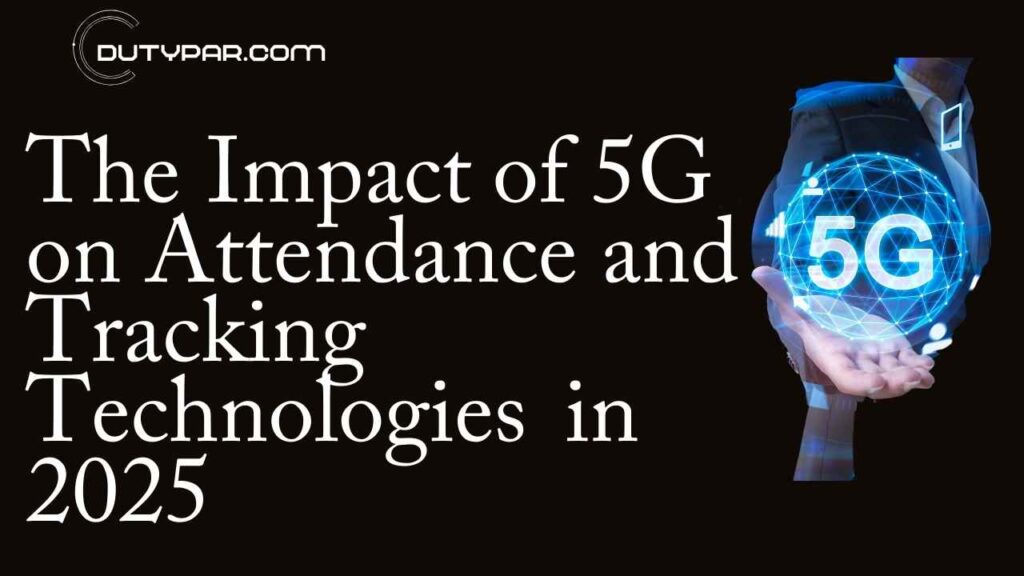
Table of contents
The advent of 5G technology is revolutionizing attendance and tracking systems, offering unparalleled speed, connectivity, and efficiency. With its ability to handle massive amounts of data and provide real-time insights, 5G is transforming how organizations monitor attendance and track assets, people, and processes. In this article, we delve into how 5G is shaping these technologies, highlighting contributions from innovative platforms like IndoAI and DutyPar.
What is 5G Technology?
5G, or the fifth generation of wireless communication technology, delivers faster internet speeds, ultra-low latency, and improved network reliability. It can support a vast number of devices simultaneously, making it ideal for advanced tracking and attendance systems. With download speeds up to 100 times faster than 4G and latency reduced to as low as 1 millisecond, 5G opens doors to applications that were previously unfeasible.
5G in Attendance and Tracking Technologies
Real-Time Attendance Monitoring
5G enables real-time attendance tracking with minimal delays. Organizations can implement biometric systems, facial recognition, and IoT-enabled devices that instantly upload data to centralized systems. This is particularly beneficial for:
- Schools and universities
- Corporate offices
- Manufacturing plants
Enhancing Asset Tracking
Asset tracking systems powered by 5G provide precise, real-time location data. Industries such as logistics, healthcare, and retail benefit immensely from these advancements. For instance:
- Logistics: Real-time tracking of shipments reduces delays and enhances customer satisfaction.
- Healthcare: Medical equipment and patient monitoring devices can be tracked more efficiently.
- Retail: Inventory management becomes seamless with live updates on stock levels.
Contributions of IndoAI and DutyPar
IndoAI: Revolutionizing Biometric Attendance Systems
IndoAI leverages 5G to offer advanced biometric attendance solutions. Its systems incorporate AI and machine learning to analyze patterns, reduce errors, and enhance security. Features include:
- Facial Recognition: High-speed recognition with 5G connectivity.
- Data Analysis: Real-time insights into attendance trends.
- Scalability: Suitable for organizations of all sizes.
DutyPar: Innovating Mobile Attendance Tracking
DutyPar specializes in mobile attendance and GPS tracking. With 5G, it provides:
- Seamless Connectivity: Ensures uninterrupted tracking, even in remote areas.
- Geo-Fencing: Automatically records attendance when employees enter specific zones.
- Customizable Features: Tailored solutions for different industries, from education to logistics.
Key Benefits of 5G in Attendance and Tracking
Increased Efficiency
The top-speed connectivity of 5G eliminates delays, allowing for real-time data processing and decision-making.
Enhanced Security
5G’s security communication protocols ensure secure data transmission, reducing the risk of breaches.
Scalability
From small startups to large corporations, 5G-powered systems are scalable and adaptable to varying needs.
Cost Savings
Automation and real-time tracking reduce manual labor and errors, resulting in significant cost savings over time.
Challenges and Future Prospects
While 5G brings numerous advantages, challenges such as infrastructure costs, device compatibility, and cyber-security risks remain. However, as technology evolves, these challenges are expected to diminish.
Looking ahead, 5G will pave the way for:
- AI Integration: Combining AI with 5G for predictive analytics.
- Edge Computing: Enhancing data processing at the source for faster results.
- IoT Expansion: Connecting billions of devices for comprehensive tracking and monitoring.
5G is undeniably a game-changer for attendance and tracking technologies, empowering organizations to operate more efficiently and securely. With contributions from innovators like IndoAI and DutyPar, the future of these systems looks promising and transformative.
FAQs
5G improves attendance tracking by providing real-time data transfer, enabling instant updates, and supporting advanced biometric systems.
Industries such as logistics, healthcare, retail, education, and manufacturing benefit significantly from 5G-powered tracking technologies.
IndoAI provides advanced biometric attendance solutions that leverage 5G for faster recognition, real-time analytics, and enhanced security.
DutyPar uses 5G to offer seamless connectivity, geo-fencing, and real-time updates, making it ideal for remote and field-based operations.





